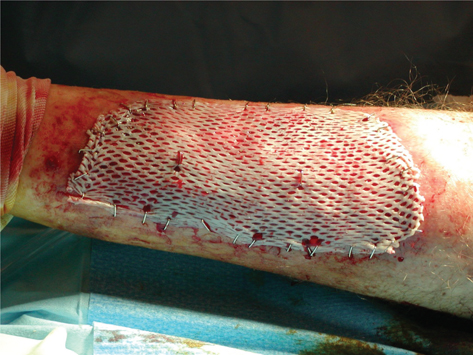Skin Grafting in Argentina
Search and Compare the Best Clinics and Doctors at the Lowest Prices for Skin Grafting in Argentina

Find the best clinics for Skin Grafting in Argentina
No clinics available
Israel offers the best prices Worldwide
Price: $ 6,002

- Home
- Argentina
WHY US?
At Medijump, we're making medical easy. You can search, compare, discuss, and book your medical all in one place. We open the door to the best medical providers worldwide, saving you time and energy along the way, and it's all for FREE, no hidden fees, and no price markups guaranteed. So what are you waiting for?

Free

Best Price

Widest Selection

Risk-Free
What you need to know about Skin Grafting in Argentina

Skin grafting is a type of surgery that involves removing skin from an area of the body and transplanting it to a different area. The transplanted skin tissue is called a skin graft. This surgery may be done to treat burns, extensive wounding or trauma, and areas of extensive skin loss caused by infection, such as purpura fulminans and necrotizing fasciitis. Skin grafting may also be used in certain surgeries that may need skin grafts for healing to occur, such as the removal of skin cancer.
There are two basic types of skin grafts:
- Split-thickness grafts involve removing the top layer of the skin (the epidermis) and a portion of the deeper layer of the skin (dermis). The skin is taken from a healthy part of the body (donor site). The grafts are used to cover large areas.
- Full-thickness grafts involve removing all of the epidermis and dermis from the donor site. This type of graft is usually used for small wounds that are located on highly visible parts of the body, such as the face.
What does a Skin Grafting Procedure Involve?
Skin grafting is performed under a general anaesthetic, which means you will be asleep and will not feel any pain during the procedure. In some cases, local anaesthetic may be used instead.
Your surgeon begins the surgery by removing skin from the donor site. For split-thickness grafts, the skin will be removed from an area of the body that is usually hidden by clothing, such as the outside of your thigh or the hip. For full-thickness graft, the skin is taken from the abdomen, forearm, groin, or an area above the collarbone.
After your surgeon removes the skin from the donor site, it will be placed carefully over the transplant area and secured with surgical dressing, stitches, or staples. If the transplant area is especially large, the skin from the donor site may be meshed in order to stretch it into a larger patch.
How Long Should I Stay in Argentina for a Skin Grafting Procedure?
For a split-thickness graft, you may need to stay in the hospital for a few days to ensure that the graft and the donor site are healing correctly. A full-thickness graft may require one to a two-week hospital stay. After you are discharged from the hospital, plan to stay in Argentina for at least 10 to 14 for more days for scheduled follow-up checkups where your doctor changes your dressing.
What's the Recovery Time for Skin Grafting Procedures in Argentina?
The donor site generally takes anywhere from several days to a week to heal. You need to avoid doing any activities that could injure or stretch the graft site, including exercise, for at least three to four weeks. Your surgeon will give you a detailed recovery timeline and tell you when it is safe to resume your normal activities.
What sort of Aftercare is Required for Skin Grafting Procedures in Argentina?
Your surgeon will give you an instruction, which may include how to care for the dressing and area around it, medicines to take, and restrictions. If possible, try to elevate the wound while sitting or lying down to reduce swelling. You should also avoid hitting or bumping the area. In some cases, your surgeon may recommend physical therapy.
What's the Success Rate of Skin Grafting Procedures in Argentina?
Skin grafting is highly successful, and the reason for your surgery determines the result. However, some skin grafts do not heal well, and you may need a second graft. Skin grafting also carries some risks, including allergic reaction to the anaesthesia, problems with breathing, bleeding, infection, blood clots, infection, loss of grafted skin, chronic pain, reduced or lost skin sensation, scarring, skin discolouration, increased sensitivity, and uneven skin surface.
Are there Alternatives to Skin Grafting Procedures in Argentina?
If you cannot or do not want to undergo skin grafting, the alternatives you can consider are:
- Letting the skin heal on its own – burns or wounds may heal without a skin graft. However, if you have a deep burn or wound that needs a full-thickness graft, scar tissue may form and prevent normal movement around the area.
- Bioengineered skin – skin grown in a lab, as well as skin from animals or cadavers, can be used instead of your own skin. Depending on the brand, bioengineered skin may be created using different materials. Some may be made of tendons from cows and shark cartilage, while others are made of human cells and a silicone mesh-like material.
- Negative pressure wound therapy – this type of treatment can help heal acute and chronic wounds, as well as severe first- and second-degree burns by applying a special dressing to the affected area and using negative atmospheric pressure.
What Should You Expect Before and After the Procedure
Before skin grafting, you may have an open wound, burns, or skin loss caused by infection. After skin grafting, all of these problems are treated and your skin would look normal again.
Whilst the information presented here has been accurately sourced and verified by a medical professional for its accuracy, it is still advised to consult with your doctor before pursuing a medical treatment at one of the listed medical providers
No Time?
Tell us what you're looking for and we'll reachout to the top clinics all at once
Enquire Now

Popular Procedures in Argentina
Prices Start From $106

Prices Start From $53

Prices Start From $14

Prices Start From $477

Recommended Medical Centers in Argentina for procedures similar to Skin Grafting

- Interpreter services
- Translation service
- Religious facilities
- Medical records transfer
- Medical travel insurance
- Health insurance coordination
- TV in the room
- Safe in the room
- Phone in the room
- Private rooms for patients available

- Interpreter services
- Translation service
- Religious facilities
- Medical records transfer
- Medical travel insurance
- Health insurance coordination
- TV in the room
- Safe in the room
- Phone in the room
- Private rooms for patients available

- Interpreter services
- Translation service
- Religious facilities
- Medical records transfer
- Medical travel insurance
- Health insurance coordination
- TV in the room
- Safe in the room
- Phone in the room
- Private rooms for patients available

- Interpreter services
- Translation service
- Religious facilities
- Medical records transfer
- Medical travel insurance
- Health insurance coordination
- TV in the room
- Safe in the room
- Phone in the room
- Private rooms for patients available
Skin Grafting in and around Argentina
Introduction
Argentina is beautiful and intriguing, the country’s cultural diversity, coupled with its beautiful nature, ensures a wide-ranging natural and cultural experience for tourists. Today, Argentina is emerging as one of the most important destinations in the world for medical tourism. Today, you will find highly-experienced healthcare professionals, medical centers with cutting-edge technology, personalized patient care, and high-quality services. The majority of medical tourists in this country arrive from Latin American countries, the USA, and Canada. These medical tourists travel to Argentina to undergo dentistry, bariatric surgery, breast implants, and ophthalmology.
Popular Cities and Regions in Argentina
Known as the ‘Paris of South America,’ Buenos Aires is the capital and largest city in Argentina. It is known for its heavy European influence, which makes it diverse and vibrant. In this lively city, you will be welcomed with a dynamic food scene, magnificent architecture, colorful murals, lively nightlife, and glamorous tango. One of the most popular places in Argentina, besides Buenos Aires, in Córdoba, which is a fascinating city with a blend of old and new. In this city, you can find DJs spinning electro-tango next to 17th century Jesuit ruins. Another famous tourist destination is Mendoza. Filled with atmospheric plazas, leady avenues, and cosmopolitan cafes, this city captivates its tourists by its laid-back vibe. Those looking to relax on a beach should definitely visit Mar del Plata or Pinamar, where you can soak up some sun and have a lot of fun.
Transport in Argentina
Ezeiza International Airport is the largest airport in Argentina, located in Greater Buenos Aires. It connects the country with almost every country in the world, such as the US, Mexico, France, the UK, and the UAE. Since Argentina is very large, traveling around the country is easier with domestic flights. However, buses are popular among those who want to appreciate the country’s landscape. The best way to travel inside cities is by renting a car.
Visas in Argentina
Citizens of several countries, including Brazil, Ecuador, and the US, can visit and stay in Argentina without a visa for up to 90 days. Most other nationalities need to apply and obtain a visa to enter the country.
Weather in Argentina
Given the immense size of the country, the weather varies widely from one region to another. Buenos Aires tends to be hot from December to March, but it is very pleasant to visit between July and August. The south of Argentina is nice to visit from December to March, while July and August tend to be very cold. North Argentina has three climate zones and areas around the Iguazu Falls are generally tropical with humid weather.
Additional Info
- Local Currency: Argentine peso (ARS) is the official currency. 1 USD is equivalent to 62 ARS.
- Money & Payments: You can find ATMs in nearly every city in Argentina. Most hotels, restaurants, and stores in major cities accept credit cards (Visa and MasterCard).
- Local Language: Spanish is the main language in the country. English is also widely spoken as it is obligatory in primary school.
- Local Culture and Religion: Argentina is an overwhelmingly Christian country. Only a small percentage of the population practices other religions, such as Buddhism, Hinduism, Islam, and Judaism.
- Public holidays: Public holidays in Argentina usually include Catholic based holidays, such as Christmas, although other religious holidays such as the Islamic New Year is celebrated. The country also celebrates historic holidays, such as Independence Day.
Popular Searches
- Plastic Surgery in Thailand
- Dental Implants in Thailand
- Hair Transplant in Thailand
- Breast Augmentation Thailand
- Gastric Sleeve in Thailand
- Gender Reassignment Surgery in Thailand
- Laser Hair Removal in Bangkok
- Botox in Bangkok
- Dermatology in Bangkok
- Breast Augmentation in Bangkok
- Coolsculpting in Bangkok
- Veneers in Turkey
- Hair Transplant in Turkey
- Rhinoplasty in Turkey
- Stem Cell Therapy in Mexico
- Rhinoplasty in Mexico
- Liposuction in Mexico
- Coolsculpting in Tijuana
- Rhinoplasty in Korea
- Scar Removal in Korea
- Gastric Sleeve in Turkey
- Bone Marrow Transplant in India
- Invisalign in Malaysia
- Plastic Surgery in the Dominican Republic
- Tummy Tuck in the Dominican Republic
- Plastic and Cosmetic Surgery in Poland
- Rhinoplasty in Poland
- Hair Implant in Poland
- Dental Implants in Poland
- IVF in Turkey